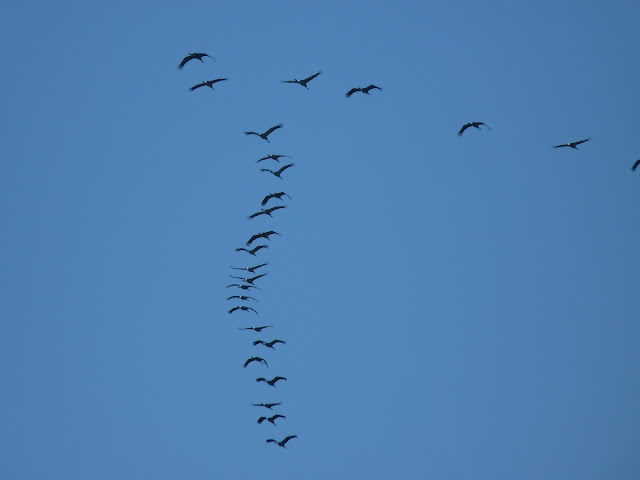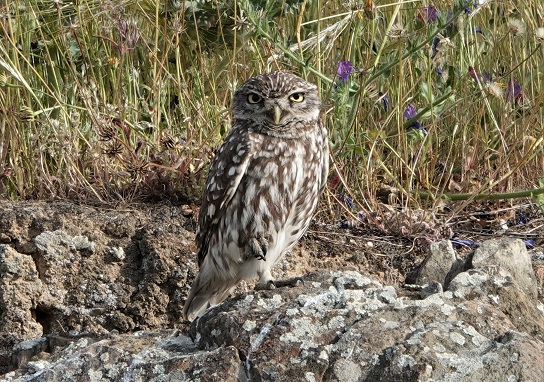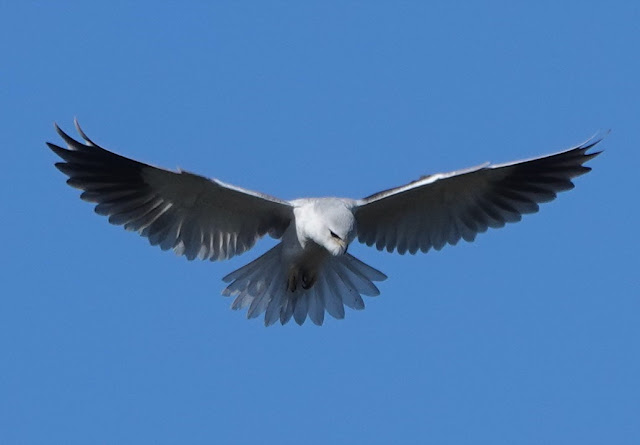Heading north-east
 |
| Migrating Common Cranes (Martin Kelsey) |
I can be anywhere in central Extremadura in late February or early March and if the weather is fine, there will be a moment late morning when I will stop what I am doing and gaze south-westward. My pause will have been demanded by an approaching, but still distant sound of cranes. I strain my eyes as I seek engagement with the flock, but experience reminds me I just need to grant myself a few seconds of patience and the birds will materialise. Mirage-like, the flock appears as a chain, with the composite birds linked in a line, or sometimes swept into a skein. As they get closer, so it becomes clearer that I am watching perhaps two hundred individual birds, but still they hold a meta-form. That is until an abrupt and noisy transmutation occurs, the shape disaggregates and the birds, chaotically at first, start spiralling. They have discovered a thermal and the benefits of lift outweigh their momentary halt in progress. Above me the flock, now several hundred metres higher than before, then undergoes a further metamorphosis, regaining its structure and composition, the blather of trumpeting subsides and with a envigourated sense of purpose the group proceeds. Their direction is a perfect north-east heading and all that remains for me to do is to cherish the moment as I watch the birds disappear into the blue.
There is nothing quite like seeing migration as it is actually happening. I had always guessed, given their orientation, they must be heading directly to Gallocanta, the well-known refuge for cranes in Aragón in north-east Spain, where they rest before the more tricky crossing of the Pyrenees. I had calculated too that a mid-morning departure from Extremadura could enable them to reach Gallocanta by evening, a distance of more than 500 kms. But it is only with the advent of satellite tracking that have we come to understand the magnificence of this migration - and it is staggering. Let me share with you the on-going story of a Lithuanian crane which spent this winter in Extremadura.
Casas de Don Pedro is a small town just east of the main rice-growing area in centre of Extremadura, at a transition between a vast expanse of dehesa and the steppe-like plains of La Serena. It lies close to the edge of the Orellana Reservoir: the biggest in the Guadiana basin in Extremadura with a surface area of over 5000 hectares, providing water mainly for the rice fields in the province of Badajoz. From the small bay of the reservoir close to the town, where there is always an interesting array of wintering birds, including sometimes local rarities like Little Gull, Greater and Lesser Scaup, one can see to the east the Sierra de las Golindrinas (the Sierra of the Swallows). I have stood beside the reservoir there and watched as, in the space of a few minutes a pair of Bonelli's Eagles cross the dehesas between the mountains and the bay, to ambush dozing Shoveler.
It was from close to Casas de Don Pedro where this Lithuanian crane set off with others at 10.25 on 28th February. By 17.53 that same day it had reached Gallocanta - a journey of about seven and a half hours. According to the Michelin routeplanner, the fastest recommended route by car would take me as long - not including stops. Since I could not have made that journey non-stop, the crane would have beaten me to Gallocanta by a very clear margin. But it is not just the capacity of cranes to migrate long distances with few breaks that is amazing, but also the speed of their flight when the conditions are good. A few days ago a young Swedish crane was recorded crossing the Pyrenees at a speed of 155 kmph!
 |
| Migrating Common Cranes (Martin Kelsey) |
Gallocanta is a remarkable stopover point for cranes, with birds arriving in the evenings to rest and feed-up, whilst others depart in the mornings. On the day that our Lithuanian bird left Extremadura there had been 80,000 cranes already gathered there. But our bird simply needed an overnight stay, because the following morning it left Gallocanta to cross the Pyrenees and enter France. It continued to fly a further 700 kms, reaching the Loire by the morning of 2nd March. Taking just two hours rest, it then travelled east, crossing Germany and reaching Hungary during the early hours of 3rd March, pausing to rest just before dawn close to the Danube, after a leg of 1150 kms. As I write, thanks to the tracking monitored by www.movebank.org, and the information shared by the Common Crane Working Group I know that this bird is now resting in the Hortobagy National Park in eastern Hungary.
My winter landscape is shaped by cranes. I am never far from their sound. Their departure affects me in Extremadura, I feel bereft. Whilst the Lithuanian bird was entering eastern France, just two days after leaving Extremadura, my eyes tracked another group of cranes as I stood beside the Belén Plains near Trujillo. These cranes too were travelling north-eastwards, just embarking on their journey. As I followed them into the distance, I was distracted by a hovering Lesser Kestrel. It was a splendid male, with mother-of-pearl-toned underwings and a clean rusty-red back. It plunged, wings held together above the body, disappearing into a swathe of long grass. It emerged carrying a mole cricket which it decapitated on the wing. What acuity of vision to spot the insect in such tall and floppy vegetation! It was not alone. There were another twenty-one Lesser Kestrels, hovering in a loose group over the grasslands. These birds too had completed a journey, reaching us from West Africa. A journey, research tells us, that would have taken just four or five days.
 |
| Male Lesser Kestrel (John Hawkins) |
My skyscape that day was criss-crossed by international arrivals and departures. My presence was that of a peripheral bystander, watching them in silence. They, however, were profoundly sculpting my very comprehension of this transition. As the cranes had defined my winter, so the Lesser Kestrels will describe my spring.



Comments